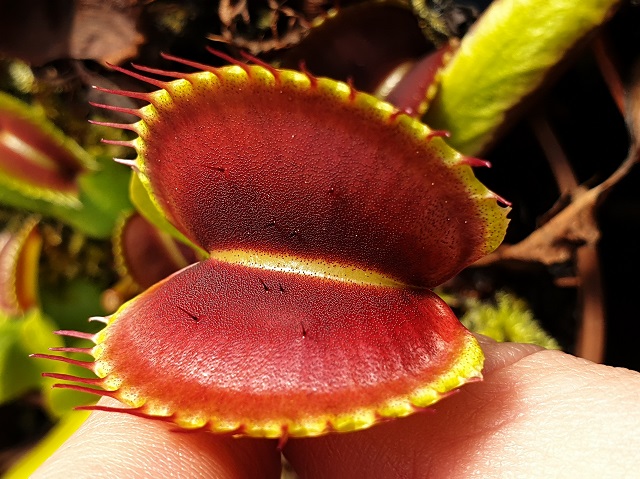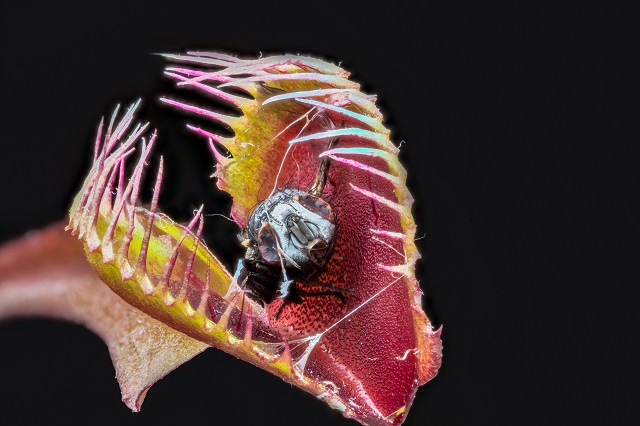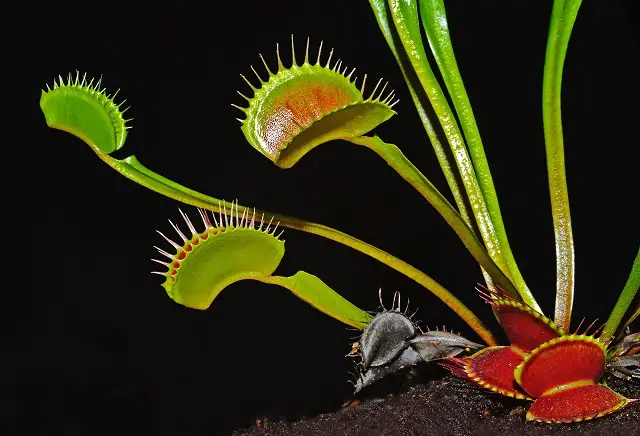Giant Venus Flytraps: Venus flytraps are a unique species of carnivorous plants known for their ability to trap and digest insects. They are native to the wetlands of North and South Carolina and have become popular among plant enthusiasts for their exotic appearance and intriguing behavior. Many people believe that Venus flytraps can grow to be quite large, creating an almost mythical aura around these fascinating plants, but this is really just fiction. In this article, we will explore the anatomy of Venus flytraps and the size they can attain. We will also examine the rumors of giant Venus flytraps and whether these tales have any truth. Get ready to discover the truth behind these captivating carnivores.
The largest Venus flytrap ever recorded was approximately 15 centimeters in diameter and was observed in the natural habitat of Venus flytraps in North Carolina and South Carolina. This size is considered to be the maximum size for Venus flytraps and is significantly smaller than what is commonly rumored about giant Venus flytraps.
The common belief that Venus flytraps can grow to be quite large.
Many people believe that Venus flytraps can grow to be quite large, with some imagining these plants as massive, predatory organisms that can easily capture and digest prey. This belief is likely due to the exotic and somewhat mysterious nature of Venus flytraps and the intriguing way in which they trap insects. However, while Venus flytraps are certainly fascinating plants, the truth about their size is a bit more nuanced than what some may expect. In reality, Venus flytraps typically only grow to be a few inches in size, and rumors of giant Venus flytraps have yet to be substantiated by scientific evidence. In this article, we will explore the size of Venus flytraps and the rumors surrounding giant specimens to understand better what these plants are capable of.

The anatomy of Venus flytraps.
Venus flytraps are known for their distinct and intriguing physical structure, which has been specifically adapted to trap and digest insects. Each Venus flytrap consists of a rosette of leaves modified into snap-trap structures. These snap-traps are made up of two hinged lobes that are held together by small, sensitive trigger hairs. When an insect lands on the trap and touches the trigger hairs, the lobes rapidly snap shut, trapping the insect inside.
The snap-traps of Venus flytraps are usually a bright green color and slightly glossy. They are typically 2 to 3 centimeters in length and grow on long stalks that rise up from the center of the rosette. The traps are held slightly open, with the hinged lobes slightly apart, in a position ready to snap shut at a moment’s notice.
Once the insect is trapped, the Venus flytrap secretes digestive enzymes that dissolve it and absorb its nutrients. The trap will remain closed for several days during the digestive process. After the insect has been fully digested, the trap will reopen, ready to trap another insect.
It is important to note that Venus flytraps can close their traps with remarkable speed. Some traps can close in less than a second after an insect touches the trigger hairs. This quick movement, combined with their unique appearance, has made Venus flytraps a popular and widely recognized species of carnivorous plants. The intricate physical structure of Venus flytraps is truly one of the marvels of the natural world and highlights the incredible adaptation of these plants to their environment.
The size of Venus flytraps.
Venus flytraps are native to the wetlands of North and South Carolina. They typically grow between 2 to 7 centimeters in size, with the rosette of leaves measuring about 5 to 15 centimeters in diameter. Despite their small size, Venus flytraps have a unique and striking appearance, with their modified leaves serving as snap-traps and the long stalks that hold the traps above the rest of the plant.
While the size of Venus flytraps can vary, the typical size of these plants is quite small and is much less than what many people imagine when they think of giant Venus flytraps. In reality, Venus flytraps cannot grow to be very large, as they are limited by the nutrients they can absorb from their environment and the size of their prey. Despite these limitations, Venus flytraps are highly adapted to their environment and can trap and digest sufficient insects to survive.
It is worth noting that Venus flytraps can grow larger when they are grown in cultivation, as they have access to a controlled environment and a steady supply of nutrients. However, even when grown in cultivation, Venus flytraps typically only reach a maximum size of about 15 centimeters in diameter. Overall, the typical size of Venus flytraps is much smaller than many people imagine, but these plants more than makeup for it with their unique and fascinating anatomy and behavior.
Why they do not grow to be very large.
Venus flytraps do not grow to be very large for several scientific reasons, including:
- Nutrient Limitations: Venus flytraps grow in nutrient-poor soils, such as bogs and wetlands, with limited access to the nutrients they need to grow. As a result, they have evolved to trap and digest insects to supplement their nutrient intake. This process is energetically expensive, and the plants can only grow so much before they reach a size where they can no longer efficiently trap and digest enough insects to sustain themselves.
- Water Availability: Venus flytraps grow in frequently wet environments but also have periods of drought. This alternating pattern of wet and dry conditions limits their growth, as the plants must conserve water during periods of drought. If the plants were to grow too large, they would become more vulnerable to water stress and would be less likely to survive.
- Photosynthesis Efficiency: Venus flytraps have a limited capacity for photosynthesis, as they have a smaller surface area relative to their overall size than other plants. As a result, they can only absorb a limited amount of energy from the sun, which limits their growth.
Overall, the scientific reasons behind why Venus flytraps do not grow to be very large are related to the limitations of their environment and the energy costs associated with trapping and digesting insects. Despite these limitations, Venus flytraps are highly adapted to their environment and can survive and thrive in nutrient-poor, wet and dry habitats.
Studies on the size of Venus Flytraps
There have been several studies that have measured the size of Venus flytraps in their natural habitats. One such study was conducted by ecologists from the University of North Carolina, who measured the size of Venus flytraps growing in the wetlands of North and South Carolina. The results of this study showed that Venus flytraps typically grow to be between 2 to 7 centimeters in size, with the rosette of leaves measuring about 5 to 15 centimeters in diameter.
Another study conducted by botanists from Duke University measured the size of Venus flytraps grown in cultivation. This study found that Venus flytraps grown in cultivation can reach a maximum size of about 15 centimeters in diameter, which is larger than the size of Venus flytraps growing in the wild. However, even when grown in cultivation, Venus flytraps are still much smaller than what many people imagine when they think of giant Venus flytraps.
These studies provide valuable information about the typical size of Venus flytraps in the wild and in cultivation. They show that Venus flytraps cannot grow to be very large, as they are limited by the nutrients they can absorb from their environment and the size of their prey. Despite these limitations, Venus flytraps are highly adapted to their environment and can trap and digest sufficient insects to survive.

Rumors of giant Venus flytraps.
There have been many rumors and legends about giant Venus flytraps that have circulated for many years. Some people believe that Venus flytraps can grow to be as large as dinner plates, with leaves several feet long that can swallow small animals whole. These rumors are likely fueled by popular depictions of giant Venus flytraps in movies, television shows, and comic books.
However, despite these rumors and legends, there is no scientific evidence to support the existence of giant Venus flytraps. Studies and research conducted by botanists and ecologists have shown that Venus flytraps typically grow to be between 2 to 15 centimeters in size, with the largest specimens reaching a maximum size of about 15 centimeters in diameter. These measurements are much smaller than what is commonly believed about giant Venus flytraps.
While the idea of giant Venus flytraps may be intriguing, it is important to recognize that these legends are not supported by scientific evidence. To better understand these fascinating carnivorous plants, it is important to rely on accurate information and scientific research, rather than legends and rumors.
Origins of the rumors about giant Venus flytraps.
The origins of the rumors about giant Venus flytraps are not well documented. However, they likely originated from popular depictions of Venus flytraps in movies, television shows, and comic books. In these depictions, Venus flytraps are often portrayed as giant, fearsome plants that can swallow small animals whole.
Another factor that may have contributed to these rumors is the lack of accurate information about Venus flytraps in the past. Prior to the advent of modern botanical research, many people had limited knowledge about these fascinating plants. This lack of information may have allowed for exaggerated accounts of their size and behavior to take hold.
Regardless of their origin, it is important to recognize that these rumors about giant Venus flytraps are not supported by scientific evidence.

Conclusion
In conclusion, the rumors and legends about giant Venus flytraps are not supported by credible scientific evidence. Venus flytraps typically grow between 2 to 15 centimeters in size, with the largest specimens reaching a maximum size of about 15 centimeters in diameter. There have been no credible reports or observations of giant Venus flytraps from reputable sources, and their biology and behavior suggest that it is unlikely that they could grow to be significantly larger without compromising their ability to survive and thrive.
It is important to rely on accurate information and scientific research when studying Venus flytraps and other species. By doing so, we can gain a deeper understanding of their biology, behavior, and role in the ecosystem and appreciate these fascinating plants for what they truly are. Whether you are a curious hobbyist, a botanist, or an ecologist, it is always important to seek out credible information and fact-check legends and rumors before accepting them as truth.


